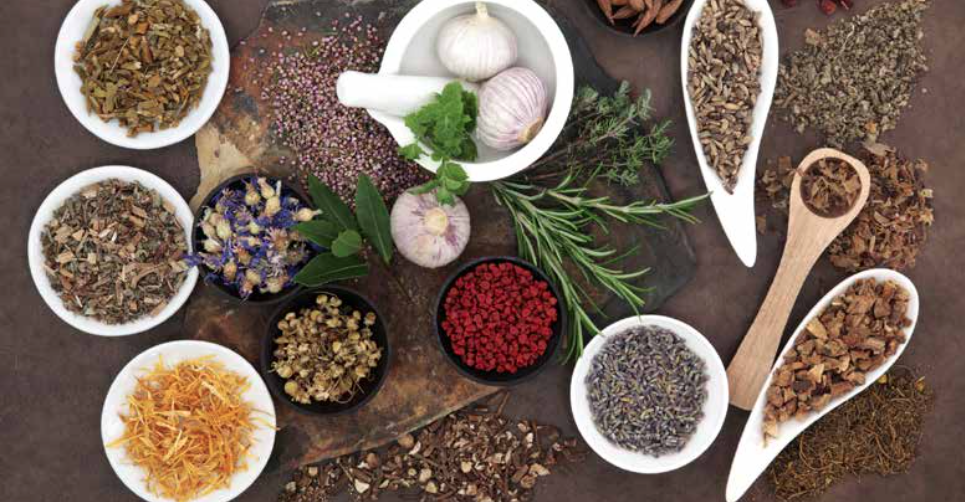Nutritional Wellness
Conclude your year-long journey toward nutritional wellness with sea vegetables, healing herbs and spices and mindful menu planning.
October Wellness Practice: Sea Vegetables
Sea vegetables have been consumed for thousands of years by ancient cultures because of their rich mineral content, which is higher than any other food source. They can contain up to 10 times more calcium than milk and eight times more iron than beef. There are three types of sea vegetables depending on their level of light exposure:
- Brown seaweed (wakame (a key miso soup ingredient), kombu and arame)
- Red seaweed (dulse, which has been linked to cholesterol reduction)
- Green seaweed (dulse, which is often used to wrap sushi)
Seaweed is usually sold in dried form. All you need to do is rinse or soak it, and it will be soft and ready to use in a wide variety of dishes. Incorporating seaweed into your meals a few times a week will give you a much-needed boost of minerals.
Get seaweed savvy by learning about the key varieties and how to use them:
- Arame: This seaweed is delicious when cooked with root vegetables, such as carrots, squash, parsnips and yams. Just soak for five minutes before use.
- Dulse: With a unique spicy and nutty flavor, this mild-tasting seaweed is a great addition to salads. No need to cook— just wash carefully before use.
- Nori: Ideal for adding to soups and rice dishes or for making sushi, nori is always ready to use—no need to soak.
- Wakame: A sweet flavor makes this a great substitute for lettuce on a sandwich. Just soak for five minutes before use.
- Hijiki: A small amount of this strong-tasting seaweed is all you need because it swells while soaking. Just soak for 20 minutes, and rinse before use.
- Kelp: Available in powder or tablet form, this daily sea vegetable supplement doubles as a healthy seasoning.
- Kombu: Used for centuries as a flavor enhancer and food tenderizer, this seaweed makes food more digestible. Add a small piece to a pot of grains or beans while cooking to enhance their nutritional value and prevent bloating. Discard after cooking.

November Wellness Practice: Healing Herbs and Spices
Herbs and spices are used in meals for both their culinary and medicinal properties, which can help elevate your health and well-being. For example, spices such as cumin, cardamom, ginger, coriander and fennel are known to reset and strengthen your digestion. Taking a balanced, whole-foods, plant-based approach to nutrition will give you the essential nutrients you need to sustain your body.
Be adventurous! Try incorporating some of these powerful herbs and spices into your daily meals. Experiment to find which combinations you like, and create your own personal spice blends. An Ayurvedic cookbook, such as Heaven’s Banquet by Miriam Kasin Hospodar, can get you started with suggestions for using spices that are especially balancing for the mind and body each season.
Helpful Tips
- Spices and herbs should be stored in airtight containers in a cool, dry place away from heat and light.
- Green herbs should be protected from direct sunlight exposure.
- Whole spices, such as cloves, cumin or bay leaf, should be added at the beginning of cooking so their full flavor can be extracted.
- Crumble dried herbs, such as oregano, just before use to release their full flavor.
- Fresh leafy herbs, such as basil or parsley, should be added in the last five minutes of cooking. More robust fresh herbs, such as rosemary, can be added earlier in the cooking process.
- Many spices release their flavors and aromatics best when sautéed in ghee (clarified butter) or oil. Be conscious when sautéing or roasting spices, as they tend to burn quickly. Remove from heat when aromas are released, and continue stirring or shaking to prevent burning.
- Remove the seeds and ribs of hot peppers to reduce the heat.
- Look for organic, non-irradiated spices that are as fresh as possible (check use by dates).

December Wellness Practice: Daily Balanced Menu Planning
We hope you have enjoyed your journey into a more healthful way of eating this year. Taking small steps every day and making better nutrition choices will move you in the direction of improving your health and well-being.
Here are some menu ideas to help you plan ahead and put what you’ve learned into action:
Breakfast: Best eaten within 30 minutes to 1 hour after waking up
Green Drinks: When making this nutrient-dense and life-promoting breakfast, incorporate a variety of fresh superfoods, such as leafy greens (kale, swiss chard, spinach, etc.), small amounts of herbs (parsley, cilantro, etc.), celery, cucumber, lemon juice and an apple. Adding lemon juice and an apple helps balance the bitterness of the greens and gives the drink a bit of sweetness.
Alternatives: Try a whole-grain cereal made from quinoa, millet or buckwheat with almond or rice milk. Leftover vegetarian soups also are enjoyable.
lunch: Best eaten between 11 a.m. and 2 p.m.
Raw Sandwiches: Top sprouted, whole-grain breads (Ezekiel or manna bread) or crackers (flax, vegetable, nut or seed) with Veganaise spread, avocados, red onions, cucumbers, carrots, spinach, lettuce and any other raw vegetables you prefer.
Salads: Put everything on your salads! Start with greens, and top with tomatoes, cucumbers, pineapple, oranges, onions, sprouts, herbs, peas, black beans, apples, salsa, brown rice, quinoa and more. Don’t forget to add a fresh, homemade salad dressing or vinaigrette.
Sandwiches: Try hummus on sprouted wheat breads or tortillas, vegetable sandwiches, almond butter and lettuce, almond butter and bananas, veggie burgers, salmon patties, or local, grass-fed, free-range
beef burgers.
Grain Salads: Combine cooled quinoa, millet or rice (or a combination of grains) with avocados, tomatoes, green onions and a pinch of sea salt.
Vinaigrettes: Enjoy organic oils and natural vinaigrettes on the above salads, steamed vegetables or fresh vegetable spears.
Dinners: Best eaten before 7 p.m. (or at least 3 hours before bed)
Dinner Ideas: Be creative, and try a variety of dinner options, including vegetarian soups, fresh vegetable juices, grain dishes, bean dishes, vegetables, steamed root vegetables, salads, mashed red potatoes with sauerkraut and peas, baked sweet potato fries, steamed or salted fish, wild-caught salmon, lentil tacos, black bean tacos or enchiladas, vegetarian lasagna or other raw food entrees.
Eat well, and be well!





